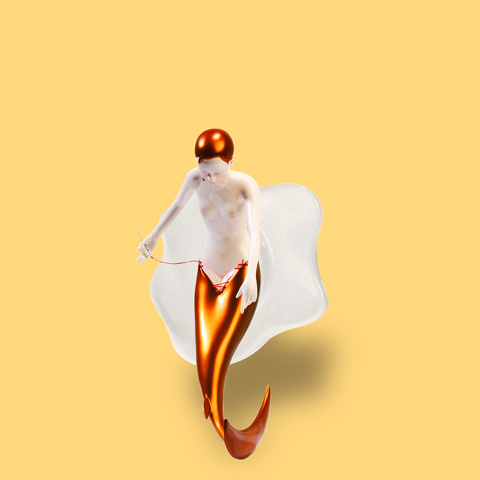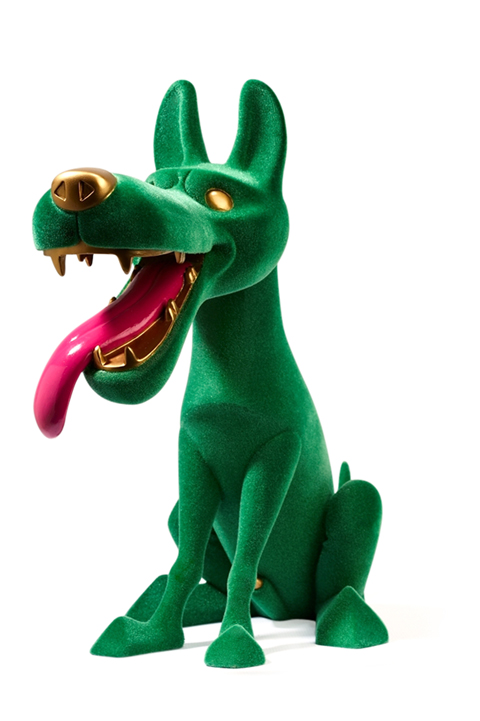Yue Minjun (岳敏君), whose paintings routinely sell for record-breaking prices, is generating buzz among collectors yet again.
But this time the hype doesn’t center around one of the Chinese artist’s multi-million US dollar price tags, but a 30cm resin toy that costs less than, say, a Louis Vuitton duffle bag.
The Kaws X Yue Minjun figure was created by Yue in collaboration with American artist and urban vinyl designer Kaws for Art for the Masses, an exhibit at the MOT Arts (概念館) in Taipei that also features toys by four other leading artists from China.

PHOTO COURTESY OF MOT ARTS AND PPGROUP
The five toys were produced in limited runs of 100 each, for sale exclusively in sets of five that cost US$10,000 (about NT$303,600) per box.
The exhibit, which ends on Sunday, seeks to make fine art more accessible and enjoyable for the public, says Imin Pao (包益民), the founder of PPGROUP, which produced Art for the Masses in collaboration with MOT Arts.
“Warhol took Campbell Soup, Marilyn Monroe and Mao Zedong (毛澤東) and turned them into Pop Art. It should also go the other way around,” says Pao.

PHOTO COURTESY OF MOT ARTS AND PPGROUP
On a more pragmatic note, PPGROUP and their Shanghai consultant, Bin Bin (彬彬) also figured they would have a better chance arousing the curiosity of the artists in the show, who represent the elite of the contemporary art scene in China, if they pitched an idea that was both novel and fun.
PPGROUP worked closely with four of the five artists, Zhou Tiehai (周鐵海), Liu Ye (劉野) Jin Nu (金釹) and Zhou Chunya (周春芽), to create toys based on their existing work.
Yue, on the other hand, wanted to create an original figure from scratch. Kaws, who already has a cult following among designer toy lovers, was brought on board, and the result is an amalgamation of their creative signatures. The toy’s face and Cheshire Cat grin are reminiscent of Yue’s enigmatic self-portraits, while its stance and outfit, a send-up of Mickey Mouse’s breeches, ears and gloves, are based on Kaws’ Companion figures.

PHOTO COURTESY OF MOT ARTS AND PPGROUP
Though Yue’s figure has been generating the most excitement among designer toy collectors because of his collaboration with Kaws, the other four figures, which are made from resin, plastic and porcelain, are no less notable.
Zhou Tehai’s figure is based on his Placebo series of paintings, in which his subject’s heads are replaced with the smug visage of Joe Camel, the erstwhile cigarette mascot. Liu Ye’s pure-white porcelain maiden stands demurely with a riding crop gripped tightly in her delicate hands. Up-and-coming young artist Jin Nu’s wannabe mermaid painstakingly sews a shark’s tail over her legs. Bright green velvety flocking covers the surface of Zhou Chunya’s dog, an attempt to capture the artist’s sweeping brush strokes in three-dimensional form.
The extremely limited run of the toys — the 50 sets made available to collectors in Taiwan sold out at MOT Arts within a week — and their very grown-up price tag hardly seems “for the masses.” But recreating the artists’ work in an easily duplicated form using inexpensive materials gives people who don’t have US$5.9 million (the price of Yue’s Execution, which last year set a record for the most expensive piece by a contemporary Chinese artist) a chance to own art by some of the world’s top living artists.
Pao estimates that a little more than half of the 50 sets sold through MOT Arts were to seasoned fine-art collectors, while urban vinyl connoisseurs and other first-time art buyers purchased the rest. PPGROUP expects to make the other 50 sets available at venues and galleries in cities around the world, including Paris, New York City, Shanghai and Tokyo.
Pao, himself a collector of designer toys, expects many artists to be resistant to the idea of making their artwork available on a massive scale. On the other hand, he also notes that the lines between consumer design and fine art are becoming increasingly blurred, citing Takashi Murakami as an example. The Japanese artist’s oeuvre includes giant fiberglass sculptures, Louis Vuitton bags and plush toys.
Art toys will never be “produced at the McDonalds level,” says Pao, before catching himself: “Actually, I think that would not be bad, if one of them ever made it to McDonalds.”

Taiwan Power Co (Taipower, 台電) and the New Taipei City Government in May last year agreed to allow the activation of a spent fuel storage facility for the Jinshan Nuclear Power Plant in Shihmen District (石門). The deal ended eleven years of legal wrangling. According to the Taipower announcement, the city government engaged in repeated delays, failing to approve water and soil conservation plans. Taipower said at the time that plans for another dry storage facility for the Guosheng Nuclear Power Plant in New Taipei City’s Wanli District (萬里) remained stuck in legal limbo. Later that year an agreement was reached

June 2 to June 8 Taiwan’s woodcutters believe that if they see even one speck of red in their cooked rice, no matter how small, an accident is going to happen. Peng Chin-tian (彭錦田) swears that this has proven to be true at every stop during his decades-long career in the logging industry. Along with mining, timber harvesting was once considered the most dangerous profession in Taiwan. Not only were mishaps common during all stages of processing, it was difficult to transport the injured to get medical treatment. Many died during the arduous journey. Peng recounts some of his accidents in

What does the Taiwan People’s Party (TPP) in the Huang Kuo-chang (黃國昌) era stand for? What sets it apart from their allies, the Chinese Nationalist Party (KMT)? With some shifts in tone and emphasis, the KMT’s stances have not changed significantly since the late 2000s and the era of former president Ma Ying-jeou (馬英九). The Democratic Progressive Party’s (DPP) current platform formed in the mid-2010s under the guidance of Tsai Ing-wen (蔡英文), and current President William Lai (賴清德) campaigned on continuity. Though their ideological stances may be a bit stale, they have the advantage of being broadly understood by the voters.

In a high-rise office building in Taipei’s government district, the primary agency for maintaining links to Thailand’s 108 Yunnan villages — which are home to a population of around 200,000 descendants of the Chinese Nationalist Party (KMT) armies stranded in Thailand following the Chinese Civil War — is the Overseas Community Affairs Council (OCAC). Established in China in 1926, the OCAC was born of a mandate to support Chinese education, culture and economic development in far flung Chinese diaspora communities, which, especially in southeast Asia, had underwritten the military insurgencies against the Qing Dynasty that led to the founding of